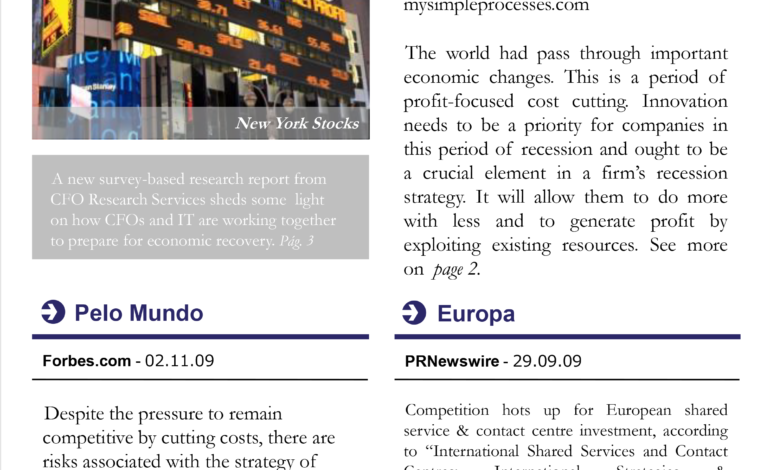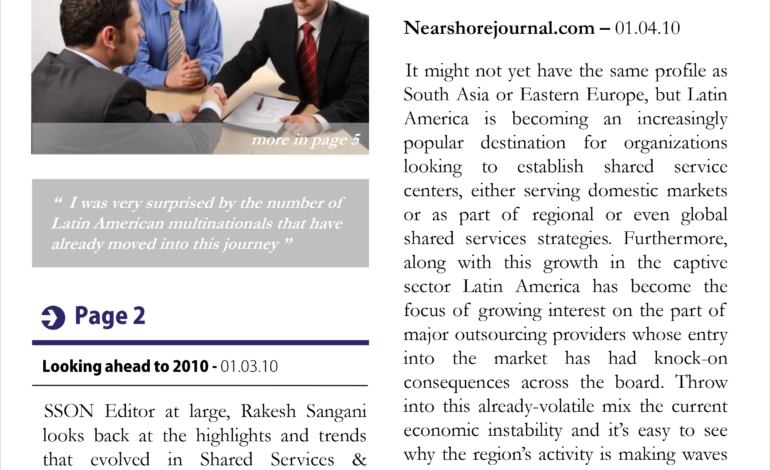TUESDAY
YEAR 1 l N º 7
JANUARY, 5th 2010
Optimized Governance
Shared Services &
Outsourcing Network
UK
Regardless of the maturity level of a
shared services organization, the
complexity and challenges posed to
governance structures is increasing.
UK
Leading companies have recognized that
a solid governance framework is essential
to an optimized shared services
organization. It serves to drive the
partnership between the shared services
group, key stakeholders and customers.
Governance defines how decisions are
made regarding scope, breadth of
services provided, delivery, and how the
operating model is managed. page 4
UK
sharedserviceslink.com - 11.26.09
sharedserviceslink.com - 12.15.09
In one recent survey, when asked, 50%
of respondents said that they now
had multi-functional shared services
versus 25%in 2003. page 2
There is a general appreciation that, if
you don‘t add value to an activity, and it
doesn‘t add value to it, it is a prime
activity to be outsourced. page 2
Europe
USA
sharedserviceslink.com – 12.02.09
businesswire.com - 12.15.09
The term ‗Centres of Excellence‘ was
largely unheard of 5 years ago. It was
only the consultants among us that
actually knew the difference between
shared services and centres of
excellence. page 3
Nominations are now being accepted for
SSON‘s
Annual
Shared
Services
Excellence Awards, part of the 14th
Annual North American Shared
Services & Outsourcing Week, taking
place March 22-25, 2010. page 3
�UK
UK
Single Function to Multi-Function
sharedserviceslink.com
November 26, 2009
The Increasing Role of Outsourcing
sharedserviceslink.com
December 15, 2009
A statistic was shared with me the other day by The Hackett
Group which I found both surprising and refreshing. In one
of their recent surveys, when asked, 50% of respondents said
that they now had multi-functional shared services versus
25%in 2003. Quite a jump in the last 5 years.
Most professionals in shared services will be able to mention
5 BPOs without too much effort. This is because BPOs are
increasing their hold over the transaction processing
market. And in the past 3 years, the grip and reach of this
hold has strengthened and widened.
The arguments for this shift significantly out weighs those
against. Firstly the treatment of transactional finance can,
and should, be applied to the transactional part of any
function in the business, so long as it does not negatively
effect the overall corporate objective of increasing
revenue/profit/market share.
There is a general appreciation that, if you don‘t add value to
an activity, and it doesn‘t add value to it, it is a prime activity
to be outsourced. According to Peter Moller, Head of the
UK Shared Services Practice, around 400 F&A BPO
arrangements have been struck since 2001. And 200 of
these deals have been realised in the last 3 years. So although
we may not be on a hocky-stick curve just yet, we‘re certainly
experiencing an accelerated upward curve.
Within HR, Procurement, IT, Legal and even Marketing,
there are activities which do not require face-time, and can
be readily automated, off shored, standardised, centralised,
and consolidated on a single system without it being
detrimental to the business.
Within all these areas,
companies are beginning to ‗chop up‘ the activities into ‗this
bit needs to be local and requires local knowledge/meetings
with the business‘ and ‗this bit can be shared
serviced/offshored/automated‘.
Secondly we are seeing the increase in Global Business
Services, not just Global Finance Services. This means that
the person who championed improvements in F&A can now
roll best practice out into the other functions, and ensure
that there is no time wasted ‗re-inventing the wheel‘. The
template used for Finance can now be utilised elsewhere.
Thirdly with ERPs now elegantly accommodating Finance,
HR and Procurement, and with shared services projects and
ERP implementations almost being treated as a single
initiaitive, more and more companies are realising that
economies of scale can be realised if a) the shared services
scope widens to cross function and b) the ERP suite is
maximised to support a cross functional shared services
strategy.
If you would like to find out more about this, Mark Burrows,
Vice President Global Shared Services of Juniper Networks
will be talking about getting multi-functional shared services
right at ‗Attaining F&A Shared Services Process Excellence‘
taking place from the 9th to the 12th March 2010 in
London.
The reason for this is that most shared services today see
BPO fitting in to their shared services delivery model to
some degree. Should your service delivery model be multitiered, chances are you have outsourced or off shored the
transaction-processing piece of AP. Or perhaps you have
outsourced the whole of AP. What shared services
organisations are considering when they look at outsourcing
is service and continuous improvements. It is no longer just
about cost, and a BPO won‘t naturally win a client just
because they are the cheapest. Nissan is very open about its
lessons learnt on outsourcing. For them first time around,
the only driver was cost. As a result some unacceptable
practices came into play, and the service standard dropped
considerably. This resulted in an entire review of the
outsourcing approach, and how enhanced service delivery
must be a key reason to outsource the activity.
Because service delivery, as well as cost, is driving the actions
of many SSOs today, there needs to be absolute comfort that
your BPO can deliver the job better than you can. Seeing
that you have had staff in AP for 20 or so years, who have a
deep knowledge of the process, people and organisation,
expecting outsiders, often thousands of miles away to do the
job better is a big ask. So investing significant energy and
attention into service provider selection, transition, and post
transition support will mean your BPO project should be a
success.
www.institutodegestao.com.br
2
�Europe
Centres of Excellence on the Rise
sharedserviceslink.com
December 2, 2009
The term ‗Centres of Excellence‘ was largely unheard of 5
years ago. It was only the consultants among us that actually
knew the difference between shared services and centres of
excellence. The landscape is very different now. In a recent
survey conducted by the Hackett Group of 150 shared
services organisations globally, over 75% of the world class
SSOs have Centres of Excellence, versus just over half of
their peer group.
So why are Centres of Excellence on the rise? 5 to 10 years
ago the 3 drivers for shared services were Cost, Cost,
Cost. There is a general agreement now that the concept of
shared services is not just applied to strip out costs, and is
not simply a cost-cutting enabler. With companies having
had the experience of seeking out low cost locations and
offshoring their activities there, only to be alarmed by the
drop in quality of some services and deliverables, a
rejuvented focus on service quality has prevailed.
To support this attention to service is the infrastructure
provided by a service delivery model which includes within
its tiering ‗Centres of Excellence‘. So what does it do? Most
shared services delivery models will have a two or three tier
structure. At the base of the pyramid will run a transaction
processing activity scooping up the kind of activity which
adds no value to the business and the business adds no value
to it. This activity really should be automated, electronic, off
shored or outsourced. Many would argue that the processes
that support these activities need to be as standardised and
process compliant as possible, to keep costs down and KPIs
like Payment on Time nice and high. Enter the role of the
2nd tier.
Finally, at the neap, sits the Centre of Excellence. These
local operations have their own definition depending on
the company you work for. But increasingly these entities
are using the data provided by the transactional part of the
shared services structure to deliver management
information, business intelligence and strategic
information to the rest of the business in order to identify
patterns, opportunites for cost savings and even
opportunities for margin growth (certainly when they
influence or indeed own pricing decisions). Centres of
Excellence are moving into the realms of adding value,
and providing more support within an advisory capacity
and financial planning.
Companies with Centres of Excellence include Cisco
Systems, Lexmark, and Steria.
USA
Call for Entries: Categories Announced the 2010
Shared Services Excellence Awards
businesswire.com
December 15, 2009
Nominations are now being accepted for SSON‘s Annual
Shared Services Excellence Awards, part of the 14th Annual
North American Shared Services & Outsourcing Week,
taking place March 22-25, 2010 at the Omni Orlando Resort
at ChampionsGate in Orlando, FL. Completed awards
nominations and applications must be submitted to Naomi
Secor,
Global
Program
Director
at
Naomi.Secor@iqpc.com by Friday, February 5, 2010.
Organizations may apply for their peers or on their own
behalf.
Other 2009 Awards Winners were as follows:
Above this transactional activity sits a Competency
Centre. This typically is the level which serves as the
‗process police‘, ensuring that every day the process
improves, and all the users within the process are 100%
compliant with the process rules. This team oversees policy,
documentation, communication to the rest of the business
regarding process Dos and Don‘ts. They will also handle
more complex transactions, or transctions which require
local knowledge. They may also manage the Help Desk to
support with ‗investigations‘ and understand the casue of
them with the idea to eliminate them for good.
• Best New Outsourced Services Delivery: Georgia-Pacific
• Best New Captive Services Delivery: NASA
• Best Mature Outsourced Services Delivery: Procter &
Gamble
• Best Mature Captive Services Delivery: Coca-Cola
• Contribution to Industry Thought Leader: Intel, Rajan
Mehndiratta, Global Accounts Payable
www.institutodegestao.com.br
3
�Around the World
Optimized Governance
Shared Services & Outsourcing Network
November, 2009
Figure1: Governance Structure Utilized by Companies
Governance Today
There is no single best-practice governance structure for
companies to adopt—no ―magic formula‖ to apply to ensure
proper governance. The most appropriate governance model
depends on the maturity of the shared services organization
and supporting initiatives. The key is that companies should
adopt the structure that best fits their organization, culture
and strategy, and that it be properly supported by
implementing solid governance elements. In addition, the
governance model should be adapted as needed over time.
An example of adaptation that may occur is evident in the
maturing process organizations go through when
transitioning from a start-up to an operational shared
services structure. During the development and
implementation stages, the majority of companies adopt the
traditional governance structure of reporting through a
senior executive (see Figure 1). However, the hybrid design
with the combination of a traditional reporting relationship
with some customer involvement is also prevalent with 35%
of companies utilizing that structure during the start-up
period.
Figure 2: Elements of Governance Structure Used by
Companies Today
Challenges with Current Models
Utlizing the results of a recent survey with leaders of
shared services groups, three aspects emerge in terms of
the challenges organizations are facing with their
governance models today (Figure 3).
Once shared services is fully operational, the hybrid
governance structure that includes significant customer
involvement is adopted by 47% of companies; the traditional
reporting structure is in place at 39% of companies; and just
14% utilize a customer council to provide oversight to the
shared services organization.
In support of the respective governance model, companies
implement a variety of process elements to support the
overall effectiveness of the shared services organization.
These elements include service level agreements,
performance metrics, and customer liaisons (see Figure 2).
The intent of these elements is to formalize quality decisionmaking, ensure that the voices of stakeholders are heard, and
to provide a consistent approach through which shared
services functions and processes are effectively identified and
implemented.
Governing Body Support
The first challenge is found in the level of support from
the governing body. Forty-one percent of organizations
report receiving limited to no support from the governing
body in terms of oversight or direction. It can be difficult
to deal with distractions such as competing priorities,
business
www.institutodegestao.com.br
4
�business unit requirements, and time needed to truly
understand the issues facing the organization. However, the
impact is a shared services group that is not optimized and
potentially not focused on the right priorities. The solution is
no mystery: in most cases the governing body does not
clearly understand its role and impact: it looks to the shared
services organization to identify, recommend, and drive
actions, given the SSO is closest to process.
Customer Connection
The second challenge is in achieving a strong customer
connection to drive service level results and process
compliance. Shared services organizations continue to
experience difficulty in monitoring and communicating
service performance levels to customers. This results in the
shared services organization not knowing where to focus
service improvement efforts, and creates the potential for
accountability and responsibility issues at the business unit
level. Unless business units trust that the shared services
organization will perform as expected in terms of quality,
process, and timeliness, they may never assume their share of
accountability and responsibility within the governance
model. Finally, the quality of the relationship between shared
services and the business units it supports varies within the
governance process. Interestingly, a large percentage of
companies indicate that they have an excellent relationship
with business unit leaders, but only a small number claim
that is the case with business unit operational contacts.
Clearly, there is an opportunity to strengthen these types of
relationships.
processes will increase. Organizations can expect to
experience continued communication opportunities with
customers, even within the shared services organization.
Shared services and outsourcing combinations will require
companies to adjust their governance models to support
and drive the necessary process improvements and
oversight. Organizations will potentially have to manage
multiple outsourcing or joint venture relationships. The
addition of stakeholders from acquisitions or service
expansion will require a review of the Governance Board
structure and processes.
Though the challenges are significant, the opportunities
for advancement and value are just as noteworthy. Those
organizations that diligently work to evaluate and refine
their governance structure have the opportunity to
become a strategic partner within the business, and to
drive innovation and process improvement, guided by the
governing body.
Governance Practices for the Future
Leading companies striving to build strategic partnerships
between shared services and the business units establish a
governance mind-set throughout the organization as a
foundation for business success. They develop a holistic
view which begins with a commitment to elevate
governance to a level of strategic importance—not just a
required task. They see governance as a means to process
improvement and as a strategic asset in identifying future
value opportunities, creating innovation and successfully
mitigating against future risks.
Consensus Decision Making
The third challenge involves removing consensus decision
making from the overall governance process as this creates a
significant barrier to continued improvement. The positives
of this type of decision-making are that it is inclusive and
allows as many stakeholders as possible to participate.
Facilitated in the right way, the process can work. However,
given the consensus decision process seeks the agreement of
most participants and the resolution or mitigation of
minority objections, the results are usually less than optimal.
Not only is the process more time consuming, but
organizations will typically experience preservation of the
status quo, disruption, or the famous Abilene Paradox
resulting in decisions counter to what is right for the
business.
Future Governance Challenges/Opportunities
In addition to existing governance challenges, as shared
services organizations mature and expand in terms of
geographies served (regional and/or global) and services
provided, the complexity of the governance structure and
processes
Companies must start by evaluating their current
governance model to assess the maturity of the enterprise.
This is necessary to match the governance structure with
the service offerings and customer service levels as the
organization grows. Companies should view this as a
―health check‖, and even consider including this as part of
their regular internal process audits. The mistake
companies can make at this point is in over-engineering
the process. A pragmatic approach with a basic structure
and guidelines can achieve impressive results.
In terms of ensuring governing body participation,
oversight, and direction, shared services organizations
need to ensure member roles are understood. Besides
developing a standard governance charter with clear
guidelines and issue resolution procedures, the shared
services group may need to take the initiative and actively
reach out to members to get them engaged. Another
practice companies can adopt to increase engagement is to
rotate governance membership, much like a board of
directors, and present it as a growth opportunity rather
than a requirement.
www.institutodegestao.com.br
5
�Leading companies are figuring out better ways to
communicate with customers as complexity increases, to
improve the overall relationship. Some organizations have
established customer councils as a way to fully connect and
drive improvement. Others have instituted regular review
cycles and are distributing ―flash reports‖ of performance
levels. Still others have focused on developing a structured
communication plan that emphasizes providing the proper
information to the correct parties at the appropriate time.
In essence these organizations are segmenting their
customers and tailoring their communications based on
the role of the receiving individual(s) from decision maker
to true customer.
Lastly, where companies can find success in managing and
responding to changing environments and complexities is
by establishing Partnership Agreements rather than
detailed Service Level Agreements. Using Partnership
Agreements allows organizations to adopt a problemsolving approach and the flexibility to adjust service
delivery according to specific business unit needs while
maintaining better performance targets.
Editores
Rodrigo Lang | Vanessa Saavedra
Conselho Editorial
Caio Fiuza
Eduardo Saggioro
Vitor Marques
Contato
pesquisas@visagio.com.br
www.institutodegestao.com.br
6
�
Shared Services News | Edição 07
Posts relacionados
Até 2017, previsão é que pelo menos 73% dos Centros passem
Pressão pela produtividade tem levado diretores e gestores de CSCs a
Atividades de TI como atendimento ao usuário, operação de sistemas e





